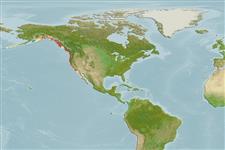Common names from other countries
Environment: milieu / climate zone / depth range / distribution range
Ekologi
; kisaran kedalaman 0 - 120 m (Ref. 95344). Temperate
Northeast Pacific.
Length at first maturity / Size / Weight / umur
Maturity: Lm ? range ? - ? cm Max length : 0.6 cm SHL jantan/; (Ref. 95344)
Found along intertidal zone in sand and mud substrate, commonly among roots of eelgrass (Ref. 95344).
Life cycle and mating behavior
Kematangan | Reproduksi, perkembang biakan | Pemijahan | telur-telur | Fecundity | Larva
Members of the class Bivalvia are mostly gonochoric, some are protandric hermaphrodites. Life cycle: Embryos develop into free-swimming trocophore larvae, succeeded by the bivalve veliger, resembling a miniature clam.
rujukan utama
Acuan | Koordinator | mitra
Bisby, F.A., M.A. Ruggiero, K.L. Wilson, M. Cachuela-Palacio, S.W. Kimani, Y.R. Roskov, A. Soulier-Perkins and J. van Hertum. 2005. (Ref. 19)
Status IUCN Red List (Ref. 130435)
status CITES (Ref. 108899)
Not Evaluated
Not Evaluated
penggunaan manusia
| FishSource |
Alat, peralatan
informasi lanjut
Umur / Saiz
Pertumbuhan
panjang-berat
panjang-panjang
Morfologi
Larva
Kelimpahan
Sumber internet
Estimates based on models
Preferred temperature
(Ref.
115969): 8.1 - 12.1, mean 9.7 (based on 92 cells).
